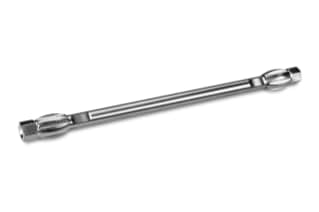
|
Chemistry |
C8 |
|
Separation Mode |
Reversed Phase |
|
Particle Substrate |
Hybrid |
|
pH Range Min |
1 pH |
|
pH Range Max |
12 pH |
|
Maximum Pressure |
6000 psi (415 Bar) |
|
Endcapped |
Yes |
|
Silanol Activity |
Low |
|
Particle Shape |
Spherical |
|
Particle Size |
3.5 µm |
|
Endfitting Type |
Waters |
|
Pore Size |
130 Å |
|
Format |
Column |
|
Surface Area |
185 |
|
System |
HPLC |
|
Particle Technology |
BEH |
|
USP Classification |
L7 |
|
Inner Diameter |
4.6 mm |
|
Length |
150 mm |
|
Carbon Load |
13 % |
|
UNSPSC |
41115709 |
|
Brand |
XBridge |
|
Product Type |
Columns |
|
Units per Package |
1 pk |

XBridge BEH C8 Column, 130Å, 3.5 µm, 4.6 mm X 150 mm, 1/pk
Offering maximum flexibility in HPLC methods development, the XBridge family of columns allows robust separations to be developed in less time and with higher confidence, empowering chromatographers to fully utilize the power of pH. With the flexibility to work over an unprecedented range of mobile phase pH and temperature ranges and seamless method migration to UPLC, the XBridge BEH C8 Column has an unmatched column lifetime. This is possible due to the trifunctional bonding and advanced end-capping used in XBridge C8 sorbent that offers superior reproducibility, performance, and column lifetime across a pH range of 1-12.
When working under accelerated low-pH test conditions feature improved low-pH stability of bonded phases when compared with other column packing materials. Because XBridge particles incorporate ethylene bridges within the silica matrix to resist particle dissolution, chemical stability is also demonstrated in accelerated high pH lifetimes. The ability to switch between high and low pH on a single column allows for less instrument downtime and significant cost savings for those working at multiple pH levels, making this an efficient piece of lab equipment.
Methods development scientists are assured that separations achieved today are reproducible year after year using the XBridge BEH C8 Column and XBridge BEH C8 Method Validation Kit, 130Å, 3.5 µm, 4.6 mm X 150 mm, 3/pk thanks to Waters’ consistent manufacturing that sets the industry standard for reproducibility between batches. Along with this, the BEH Technology in these columns offers improved performance and a long column lifetime under even the most demanding LC conditions, far exceeding conventional HPLC column brands under both low and high pH conditions.
What Solvents Should I Use With XBridge BEH C8 Columns?
For maximum column performance, you should use high-quality chromatography grade solvents and all aqueous buffers should be buffered prior to use. Pall Gelman Laboratory Acrodisc filters are recommended by Waters. Be cautious of solvents containing suspended particulate materials as they will generally clog the outside surface of the inlet distribution frit of the column, which will result in higher operating pressure and poor performance. Before using any solvents, they should be thoroughly degassed to prevent the formation of bubbles in the pump and detector. It is also recommended you use an on-line degassing units, especially when running low-pressure gradients.